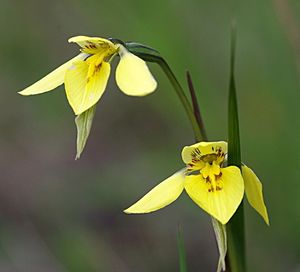Common golden moths facts for kids
Quick facts for kids Common golden moths |
|
|---|---|
 |
|
| Scientific classification | |
| Genus: |
Diuris
|
| Species: |
chryseopsis
|
The Common golden moth (scientific name: Diuris chryseopsis) is a type of orchid found only in south-eastern Australia. It's also sometimes called the small snake orchid. This plant is quite common and grows in many places like woodlands. You'll often see them growing together in groups. Each plant can have up to four beautiful, golden-yellow flowers that hang downwards. It looks a lot like some other orchids and can even mix with them to create new kinds of Diuris plants.
Contents
About the Common Golden Moth Orchid
What it Looks Like
The Common golden moth orchid is a plant that grows from a tuber (a swollen underground stem, like a potato). It's a perennial plant, meaning it lives for more than two years. This orchid has two to five green, thin leaves, sometimes up to eight. These leaves are about 50–220 mm (2–9 in) long and 2–3.5 mm (0.08–0.1 in) wide, growing in a loose bunch.
The plant can have up to four lemon-yellow flowers that hang down. These flowers often have brownish marks and are about 17–30 mm (0.7–1 in) wide. They grow on a stem that can be 100–300 mm (4–10 in) tall.
Flower Parts
The flower has different parts:
- The dorsal sepal (the top part of the flower) stands mostly upright. It's shaped like an egg or a spear, about 10–15 mm (0.4–0.6 in) long and 4–8 mm (0.2–0.3 in) wide.
- The lateral sepals (the two side parts) are thin and spear-shaped. They are about 15–25 mm (0.6–1 in) long and 2–3.5 mm (0.08–0.1 in) wide, pointing downwards.
- The petals are shaped like a spear or a narrow egg. They are 8–20 mm (0.3–0.8 in) long and 3.5–7 mm (0.1–0.3 in) wide. They grow on a dark stalk about 3–5 mm (0.1–0.2 in) long and point sideways.
- The labellum (the lip of the orchid) is about 14–20 mm (0.6–0.8 in) long and has three parts called lobes.
- The middle lobe is egg-shaped or heart-shaped, 9–16 mm (0.4–0.6 in) long and 7–12 mm (0.3–0.5 in) wide.
- The side lobes are oblong (like a rectangle with rounded ends) or wedge-shaped. They are 2–3.5 mm (0.08–0.1 in) long and 1–2 mm (0.04–0.08 in) wide.
- The callus (a raised area on the labellum) is very hairy or bumpy near its base. It gets thinner towards the tip of the labellum.
These orchids usually bloom from August to October.
Naming the Orchid
How it Got its Name
The Diuris chryseopsis was officially described in 1998 by a botanist named David Jones. He found a sample of the plant in a field near the Symmons Plains Raceway.
The scientific name chryseopsis comes from two Ancient Greek words:
- chryseos means "golden."
- opsis means "sight," "look," or "appearance."
So, the name refers to the golden color of its flowers.
Where it Lives
The Common golden moth orchid likes to grow in damp areas. You can find it in forests, woodlands, and grasslands. It is found in south-eastern New South Wales, Tasmania, and Victoria, where it is very common. It might also grow in south-eastern South Australia.
This orchid looks similar to other Diuris species. It often creates hybrids (new plants formed when two different species mix) with other Diuris orchids that live in the same areas.

